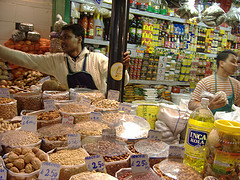- Big Oil vs Big Corn. The Economist says End the ethanol tax.
- Grow edamame, young farmer.
- Agri experts call for a comprehensive food policy in Pakistan. Not gonna happen. There or anywhere else.
- But is this where it would start?
- Utterly confused by second-hand sources, I’m sending you straight to the horse’s mouth for information on Plant genetic resources and seeds: Community resilience in the face of change, a three week course in November 2013.
- Yeah, but will they teach you about Terralingua’s Vitality Index of Traditional Environmental Knowledge?
- CIMMYT doubles its haploids centrally now, at least in Africa.
- He coulda been a contender, but instead he breeds pigeons. Which is just as good, in my estimation.
- Photo essay on Sudan’s gum arabic industry.
- ILRI spell out the pros and cons of livestock. Always good to have the data.
- Who needs a national seed bank when you can have local ones like this one in Spain?
- Remember that draft SADC seed law RAFI didn’t like yesterday? Well, they’re not alone.
- Remember that Syngenta tomato that won that award yesterday? Well, now try these.
Nibbles: Property rights, Dryland crops, New tomato, CGIAR genebanks, Quinoa in US, Wasps and figs, Ancient New World agriculture, Allium CWR, SADC seed law, ESA, Coconut pollination
- Why tenure matters. And why it doesn’t.
- Book on alternative crops for dry areas. Not that alternative, settle down. And anyway, how do they do in mixtures?
- And the award for Best New Variety of the Year goes to…
- CGIAR Consortium hires private sector biotech expert to oversee genebanks et al.
- US set to grow more quinoa. Shame on you, taking the bread out of the mouths of Andean peasants!
- Save our figs!
- Malanga and cassava important on Mayan menu. And maize maybe not so much on Pueblan one as thought.
- New onion wild relative spotted in Central Asia.
- GRAIN objects to new one-size-fits-all SADC seed law.
- Ecological Society of America discovers agriculture.
- Indian institute trains first female coconut pollinators.
Nibbles: Roman gardens, Gwich’in video, Medicinals, Crowdsourcing, Genomics in general, Genomics in particular, ICARDA strategy, Growing plantains, Fonio, Fancy chocolate
- All nice and rested, we are resolutely back. With the peaceful gardens of Pompeii and Herculaneum.
- With the very different lifeways of the Gwich’in.
- With Cassandra Quave and her quest for medicinal plants. Not among the Gwich’in, alas.
- With Jacob van Etten and his quest for crowdsourcing. Also not among the Gwich’in, who can’t buy a break, it seems.
- With Eve Emshwiller (and others) on the joys of genomics.
- With Mary Ndila and her efforts to get to the bottom of the good cow/bad cow dichotomy. Using genomics, natch.
- With ICARDA’s exhortation to be smart and systematic.
- With CTA’s instructions on how to plant better plantains. Presumably by being smart and systematic? Kinda. Not, apparently, by varietal mixing, though.
- With ICRISAT’s pean to fonio. And now I need another holiday.
- Or a piece of chocolate.
The politics of the language of food
The always stimulating Thinking Allowed on BBC4 devoted last week’s episode to food. There were two interviews. The first was with linguist Guy Cook on his project looking at the specific words and language strategies that the food industry uses to describe its wares. There’s a paper about it too. A number of interesting observations in there, but here’s the one that stuck with me: Prof. Cook’s databases suggest that the word “frankenfoods” is now used much more often by GM enthusiasts to ridicule their opponents than by the green lobby to describe the alleged dangers of playing God.

Nowt so queer as folk, and nowt like language to prove it.
Brainfood: Coconut and climate, Cereal biofortification, Ancient tuber oat grass, Grape diversity, Shade cacao, Ancient Central Asian ag, Diversity of knowledge, Edible canna
- Climate change and coconut plantations in India: Impacts and potential adaptation gains. Seems we don’t need to worry about coconut in India. Much. Overall.
- Biofortification of cereals to overcome hidden hunger. Need to understand mineral uptake and transport mechanisms better. But once we do…
- Evaluating prehistoric finds of Arrhenatherum elatius var. bulbosum in north-western and central Europe with an emphasis on the first Neolithic finds in Northern Germany. May just have had a ritual role.
- Genetic diversity and population structure assessed by SSR and SNP markers in a large germplasm collection of grape. High diversity despite duplication. Ecogeographic groupings within the cultivated material. Genetic core more genetically diverse than phenological core, though similarly phenotypically diverse. Information will revolutionize breeding. No, not really.
- Shade Tree Diversity, Cocoa Pest Damage, Yield Compensating Inputs and Farmers’ Net Returns in West Africa. Best thing is to have a diverse shade canopy, but under 50%.
- Agricultural production in the Central Asian mountains: Tuzusai, Kazakhstan (410‐150 b.c.). Yes, agriculture. Not just pastoralism.
- Diversity of Plant Knowledge as an Adaptive Asset: A Case Study with Standing Rock Elders. Differences among individuals may be just that, rather than “lack of cultural consensus” and may be adaptive as circumstances change.
- The Origin of Southeastern Asian Triploid Edible Canna (Canna discolor Lindl.) Revealed by Molecular Cytogenetical Study. C. indica var. indica and C. plurituberosa are the proud and newly-identified parents.